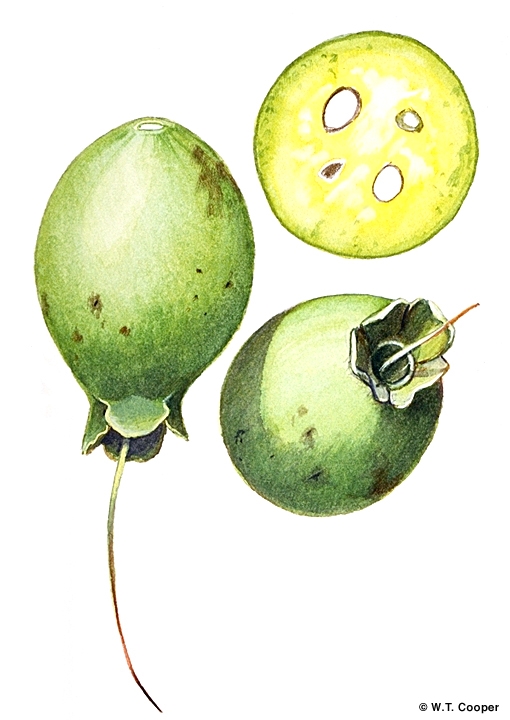Australian Tropical Rainforest Plants - Online edition
Planchonia careya (F.Muell.) R.Knuth




Knuth, R. (1939) Das Pflanzenreich Heft 105(1) : 56.
Cocky Apple; Cockatoo Apple; Billy Goat Plum; Apple, Cocky; Apple, Cockatoo; Plum, Billy Goat
Papery (papyraceous), glabrous, discolorous, glossy above, dull on lower surface, aging red; obovate to broadly ovate, the smallest leaves spathulate, 50-120 x 28-76 mm; apex emarginate to bluntly acuminate, tip obtuse; finely crenulate or sometimes almost entuire; base long attenuate; midrib flat above; lateral nerves in 9-12 pairs, forming indistinct loops inside the blade margin, angled at 60 degress to midrib; petiole 6-32 mm long.
Racemes with few, large flowers; pedicels puberulous, 5-20 mm long. Calyx tube green, 7-15 mm long; largest lobes 6-11 x 4-8 mm, the smallest 4-6 x 3-4.5 mm. Petals white, pink at the base, greenish on the back, 15-32 x 6-14 mm. Staminal tube 4-11 mm long; filaments ca. (90)120-170 per flower, 25-45 mm long. Style 35-70 mm long.
Cotyledons linear-elliptic, about 5-15 mm long. At the tenth leaf stage: leaves +/- obovate, apex obtuse, base attenuate, margin crenate and undulate, leaf blade about 50-70 x 20-30 mm; midrib raised on the upper surface; stipules small and inconspicuous; petiole narrowly winged, the wings extending down the stem to the next leaf. Hypocotyl swollen, +/- carrot-like (Daucus carota). Seed germination time 10 to 13 days.
Occurs in WA, NT, CYP, NEQ, CEQ and southwards as far as coastal central Queensland. Altitudinal range from sea level to 600 m. Grows mainly in open forest but also found on the margins of rain forest and in monsoon forest. Also occurs in New Guinea.
The bark of this species is a well known fish poison in North East Queensland.
Food plant for the larval stages of the Copper Jewel and Common Tit Butterfly. Common & Waterhouse (1981).
This species has been used as a fish poison. It may also have medicinal properties. The fruit has been reported as edible. (http://www.sgapqld.org.au/bushtucker4.html)
The bark of this tree contains saponin, a chemical which makes a soap-like froth when boiled in, or shaken with, water. Cribb (1981).





